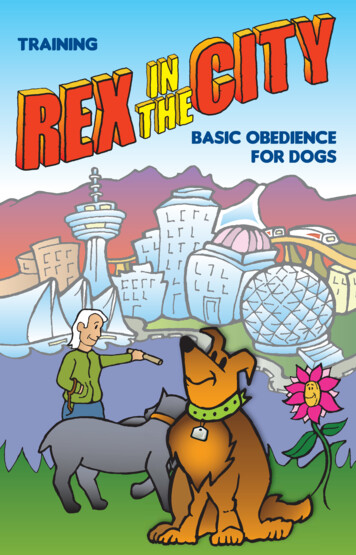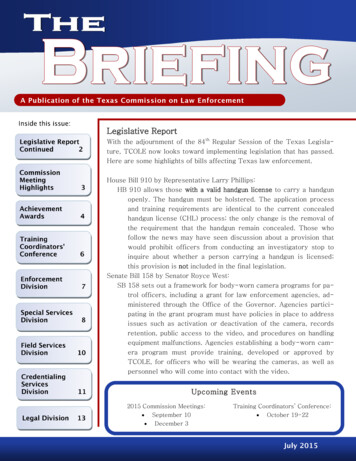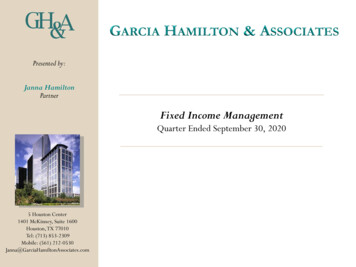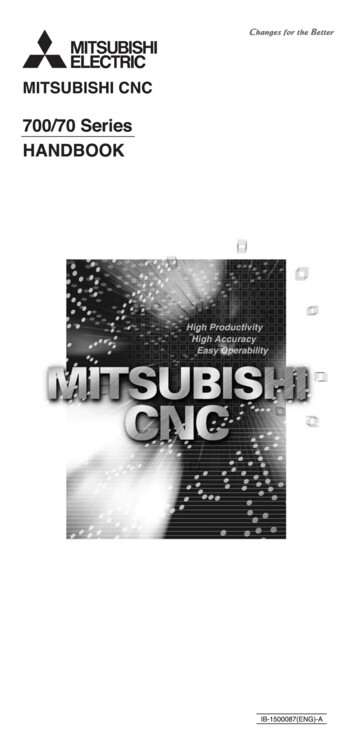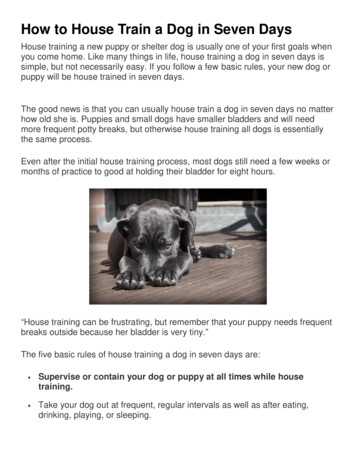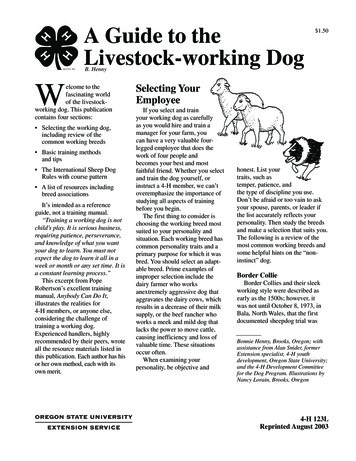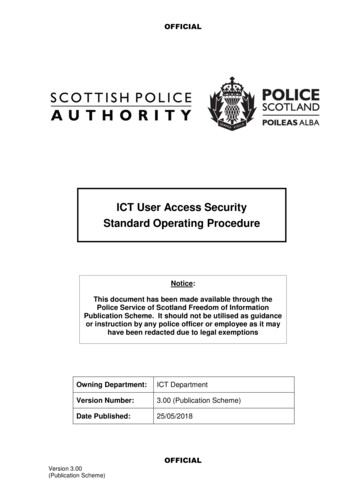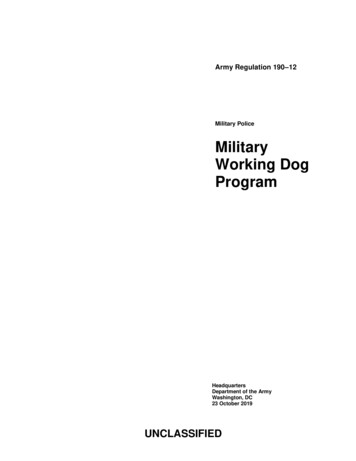
Transcription
Army Regulation 190–12Military PoliceMilitaryWorking DogProgramHeadquartersDepartment of the ArmyWashington, DC23 October 2019UNCLASSIFIED
SUMMARY of CHANGEAR 190–12Military Working Dog ProgramThis administrative revision, dated 2 December 2019 -oCorrects formatting and grammatical errors (paras 2–2b(2) and 5–4).This major revision, dated 23 October 2019 -oUpdates the organizational structure (para 2–1).oUpdates the qualifications and responsibilities for military working dog program managers, kennel masters, plansnoncommissioned officers, and military working dog handlers (para 2–2).oAdds the Military Working Dog equipment sets (para 3–1).oAdds the Law Enforcement Vehicle Allocation Methodology (para 3–3).oAdds Military Working Dog budget requirements (para 4–5).oUpdates Military Working Dog authorizations and requisitions (para 4–6).oAdds the Field Evaluation Questionnaire requirement (para 4–8)oUpdates the Military Working Dog adoption process (para 4–11)oUpdates the Military Working Dog safety procedures, which includes the use of the muzzle and bite reporting (para4–12).oAdds the passport requirement for all explosive detector dog handlers (para 4–13).oUpdates the movement of Military Working Dogs (para 4–14)oAdds the standard operating procedures requirement (para 4–15)oAdds the key control requirements (para 4–16)oUpdates the Military Working Dog sustainment training requirement (para 5–2).oAuthorizes the use of the Electronic Training Collar (para 5–4).oAdds the standardization of the military working dog certification process (chap 6).oAdds the requirement and defines the Certification Authority Mentorship Program (para 6–1).oUpdates the utilization of military working dogs (chap 7).oUpdates the veterinary information (chap 8).oUpdates the kennel security requirements (app B-1).
HeadquartersDepartment of the ArmyWashington, DC23 October 2019*Army Regulation 190–12Effective 23 November 2019Military PoliceMilitary Working Dog ProgramHistory. This publication is an administrative revision. The portions affected bythis administrative revision are listed in thesummary of change.Summary. This regulation covers themanagement, operational utilization, training, and command and control of ArmyMilitary Working Dogs. This revision addsthe standardization of the certification process, requirement for personnel to possessofficial passports, equipment sets andbudget requirements.Applicability. This regulation applies tothe Regular Army, the Army NationalGuard/Army National Guard of the UnitedStates, and the U.S. Army Reserve, unlessotherwise stated. It also applies to the Department of the Army Civilian Police andcontracted personnel supporting domesticor overseas contingency operations in support of the United States Army - under Federal jurisdiction - with the exception of import requirements. Army Military WorkingDogs are not subject to State or host nationlaw. It applies to all Army personnel whoare involved in the care, training, and employment of Military Working Dogs. Portions of this regulation that prescribe specific conduct are punitive, and violations ofthese provisions may subject offenders topunitive action under the Uniform Code ofMilitary Justice.Proponent and exception authority.The proponent of this regulation is theProvost Marshal General. The proponenthas the authority to approve exceptions orwaivers to this regulation that are consistentwith controlling law and regulations. Theproponent may delegate this approval authority, in writing, to a division chief withinthe proponent agency or its direct reportingunit or field operating agency, in the gradeof colonel or the civilian equivalent. Activities may request a waiver to this regulationby providing justification that includes afull analysis of the expected benefits andmust include formal review by the activity’s senior legal officer. All waiver requests will be endorsed by the commanderor senior leader of the requesting activityand forwarded through their higher headquarters to the policy proponent. Refer toAR 25–30 for specific guidance.Army internal control process. Thisregulation contains internal control provisions in accordance with AR 11–2 andidentifies key internal controls that must beevaluated (see appendix C).Supplementation. Supplementation ofthis regulation and establishment of command and local forms are prohibited without prior approval from the Provost Marshal General (DAPM– MPO), 2800 ArmyPentagon, Washington, DC 20310–2800.Suggested improvements. Users areinvited to send comments and suggestedimprovements on DA Form 2028 (Recommended Changes to Publications and BlankForms) directly to the Provost MarshalGeneral (DAPM–MPO–LE), 2800 ArmyPentagon, Washington, DC 20310–2800.Distribution. This regulation is availablein electronic media only and is intended forthe Regular Army, the Army NationalGuard/Army National Guard of the UnitedStates, and the U.S. Army Reserve.Contents (Listed by paragraph and page number)Chapter 1Introduction, page 1Purpose 1–1, page 1References 1–2, page 1Explanation of abbreviations and terms 1–3, page 1Responsibilities 1–4, page 1Records management (recordkeeping) requirements 1–5, page 3Chapter 2Military Police Detachments, page 3Organizational structure 2–1, page 3Military working dog personnel qualifications and responsibilities 2–2, page 4*This regulation supersedes AR 190-12, dated 11 March 2013 and DA Pam 190-12, dated 30 September 1993.AR 190–12 23 October 2019UNCLASSIFIEDi
Contents—ContinuedChapter 3Military Working Dog Equipment, page 7Military working dog equipment sets 3–1, page 7Military working dog shipping crates 3–2, page 7Law enforcement vehicle allocation methodology 3–3, page 7Chapter 4Management and Administrative, page 8Inspections 4–1, page 8Monthly military working dog status report 4–2, page 8Working dog management system 4–3, page 8Military working dog training records / probable cause binders 4–4, page 9Budget 4–5, page 9Military working dog authorizations and requisitions 4–6, page 10Accountability of military working dogs 4–7, page 10Field evaluation questionnaire 4–8, page 11Military working dog dispositions 4–9, page 11Excess military working dogs 4–10, page 11Military working dog adoptions 4–11, page 11Military working dog safety procedures 4–12, page 12Passports 4–13, page 13Movement of military working dog 4–14, page 13Standard operating procedures 4–15, page 14Key control 4–16, page 14Chapter 5Military Working Dog Training, page 14Military working dog initial training and transition evaluation 5–1, page 14Military working dog sustainment training 5–2, page 15Military working dog gunfire training 5–3, page 16Electronic training collar 5–4, page 16Military working dog validations 5–5, page 16Training assistance teams 5–6, page 17Explosive training aids 5–7, page 17Drug training aids 5–8, page 19Chapter 6Military Working Dog Certification Process, page 19Military working dog certification authority 6–1, page 19Military working dog certification outline 6–2, page 20Patrol explosives detector dog/patrol drug detector dog/patrol explosives detector dog-enhanced/specialized search dogcertification 6–3, page 20Military working dog decertification 6–4, page 21Chapter 7Military Working Dog Utilization, page 21Military working dog searches and utilization requirements 7–1, page 21Police operations 7–2, page 22Explosive detector dog support for agencies outside of the Department of Defense 7–3, page 22Overseas contingency operations 7–4, page 23Military working dog use of force 7–5, page 23Use of contract working dogs 7–6, page 24Chapter 8Veterinary Services, page 24Veterinarian responsibilities 8–1, page 24iiAR 190–12 23 October 2019
Contents—ContinuedMilitary working dog conditioning program 8–2, page 25Diet and weight management 8–3, page 25Safety in veterinary facilities 8–4, page 26Deployment categories (category status) 8–5, page 26Chapter 9Engineer Mine Detector Dog, page 26Mine detector dog certification 9–1, page 26Use of a mine detector dog 9–2, page 28Mine detector dog training aids 9–3, page 28AppendixesA. References, page 30B. Kennel Facilities, page 34C. Internal Control Evaluation, page 37GlossaryAR 190–12 23 October 2019iii
Chapter 1Introduction1 –1. PurposeThis regulation prescribes responsibilities, policies, and procedures for the direction, management, and control of the ArmyMilitary Working Dog (MWD) Program. It explains how MWD teams are used in garrison and combat support missionsincluding area security; movement and mobility support operations; law and order; and force protection, including drug,human, landmine, firearm, ammunition, and explosive detection. This regulation is to be used with the Department ofDefense Directive (DODD) 5200.31E, Air Force Instruction (AFI) 31 –126/ Army Regulation (AR) 700–81/ Naval Operations Instruction (OPNAVINST) 5585.2C/ Marine Corps Order (MCO) 5585.6, and the Army Techniques Publication(ATP) 3–39.34.1 –2. ReferencesSee appendix A.1 –3. Explanation of abbreviations and termsSee the glossary.1 –4. Responsibilitiesa. Assistant Secretary of the Army (Manpower and Reserve Affairs). The ASA (M&RA) will provide oversight responsibility for the PMG in the development of Armywide policies for the MWD Program.b. Deputy Chief of Staff, G–1. The DCS, G–1 will(1) Develop assignment policy of Military Occupational Specialty (MOS) 31K personnel in accordance with AR614–200.(2) Develop policy, along with United States Army Military Police (MP) School (USAMPS), for career managementof 31K personnel.c. Commanding General, U.S. Army Corps of Engineers. On behalf of the Chief of Engineers, the CG, USACE willdevelop designs for MWD kennel facilities in coordination with the Office of the Provost Marshal General (OPMG),Maneuver Support Center of Excellence, USAMPS, U. S. Army Installation Management Command (IMCOM) and Medical Command.d. The Surgeon General. The Surgeon General will(1) Assist in the development of design criteria for MWD kennel facilities in coordination with the OPMG, USAMPS,USACE, and IMCOM.(2) Provide complete veterinary health care services for MWDs, including medical evaluation of MWDs’ fitness forduty.(3) Provide professional guidance to commanders and training to handlers for animal health husbandry, including care,first aid, chemical, biological, radiological, nuclear, and high yield explosives protective measures for animals, feeding,kennel design, and sanitation.e. Provost Marshal General. The PMG will(1) Develop policies, standards, and procedures for the management, training, certification, inspections, employment,and care of MWDs.(2) Manage the Army’s MWD certification program.(3) Validate the Schedule 75 submissions from the Army commands (ACOMs), Army service component commands(ASCCs), and direct reporting units (DRUs) during the Program Objective Memorandum (POM) Cycle.(4) Manage the QLPR Management Decision Package (MDEP) for the MWD Program.(5) Conduct Army Protection Program Assessment (APPA) of ACOM, ASCC, and DRU MWD Programs trienniallyto ensure:(a) Proper managerial oversight and execution of the MWD Program.(b) Provide policy for the logistical sustainment of the MWD Program.(6) Staff action office to provide OPMG MWD oversight with the Headquarters, Department of the Army (HQDA)staff elements, in the development, modifications, and recommended changes in MWD force structure requirements andauthorizations, through the Total Army Analysis (TAA) with the DCS, G–3/5/7.(7) Review and approve HQDA MWD certification authorities.AR 190–12 23 October 20191
(8) Serves as a voting member on the Department of Defense (DOD) MWD Executive Agent (EA) Joint Services MWDCommittee.(9) Coordinate and direct Army MWD support for U.S. Secret Service (USSS) and Office of the Secretary of Defense(SECDEF) in accordance with Section 3056, Title 18, United States Code (18 USC 3056) as requested by the Air ForceSecurity Forces Center (AFSFC).(10) Coordinate and direct Army MWD support for Department of State (DOS) and Defense Support to Civil Authorities (DSCA).(11) Compile military standard requisitioning and issue procedures (MILSTRIP) data submitted by MWD ProgramManagers (PMs) and product managers.(12) Validate and manage the Army MWD requisitions.(13) Assign newly qualified MWDs to ACOMs, ASCCs, and/or DRUs in direct coordination with the 341st TrainingReadiness Squadron (TRS) Logistics Section, Joint Base San Antonio (JBSA) Lackland Air Force Base (AFB), TX.(14) Provide assistance to the U.S. Army Human Resources Command (HRC) 31K Assignment Manager with senior31K personnel (master sergeant/first sergeant population) talent management as it pertains to the MWD program state ofreadiness.(15) Provide MWD Support to law enforcement agencies (LEA) in accordance with DODD 3025.18.(16) Provide HQDA oversight for sourcing of MWD worldwide deployments.(17) Serve as the Army central point of contact for any matter pertaining to MWDs, including coordination with orbetween HQDA and the DOD MWD EA (U.S. Air Force); other Military Services; federal, state, and local authoritiesconcerning the training and utilization of MWD teams.(18) Monitor development of training requirements and equipment for MWDs and their handlers, and ensure that training meets Army combat support, law and order, and force protection mission needs in coordination with the USAMPS, aswell as assured mobility mission needs in coordination with the U.S. Army Engineer School (USAES).(19) Review all MWD support contracts.f. Commanding General, U.S. Army Training and Doctrine Command. The CG, TRADOC will—(1) Assign a lead TRADOC school to formulate concepts, doctrine, organizational structure, materiel objectives, andrequirements to employ Army MWDs. The responsible organization will serve as the TRADOC clearing house for thevetting of all of the following:(a) Development of Army training standards and procedures for Army MWDs, handlers, and supervisory personnelconducted by the 341st TRS, the Air Education Training Command (AETC), and the Mine Detector Dog (MDD) Courseconducted at Fort Leonard Wood, Missouri.(b) Assignment of a sufficient number of instructors to meet annual Army Trained Dog Requirement (TDR) and TrainedPersonnel Requirement at JBSA-Lackland AFB, TX and the MDD Course.(c) Development of MWD concepts and those actions necessary to implement concepts (doctrine, organization, training, materiel, leadership, personnel, facilities).(d) Development of Army MWD employment doctrine for combat support and law enforcement (LE).(e) Development of Army MWD training equipment requirements in coordination with the 341st TRS and AETC.USAES assists with the development for MDD equipment.(2) Evaluate MWD information (directives, ideas, concepts, requests for assistance) that flow to HQ, TRADOC frommany sources, including HQDA, other Services, other commands, and individuals.g. Commanding General, Human Resource Command. The CG, HRC will—(1) Administer and supervise all military personnel management aspects of the MWD program.(2) Coordinate course training personnel requirements and assignment of MWD handlers to authorized positions.(3) Develop policy, along with USAMPS, for career management of Army MWD handlers.h. Commanders of Army commands, Army service component commands, and direct reporting units. Commanders ofACOMs, ASCCs, and DRUs will—(1) Appoint a qualified noncommissioned Officer (NCO) or DA Civilian as the ACOM/ASCC/DRU MWD PM.(2) Include requirements and authorizations for MWDs in applicable documents per AR 71–32.(3) Budget for MWD operational requirements and MWD program support not provided by the DCS, G –4 and DCS,G–8.(4) Supervise subordinate units, installations, or activities to ensure effective management of MWD programs and utilization of MWD team assets.(5) Monitor the MWD certification program to ensure the proficiency of MWD teams.(6) Notify the OPMG of all certification, recertification, or decertification actions by electronic message.(7) Request appointment of MWD certification officials to the OPMG for approval.2AR 190–12 23 October 2019
(8) Compile data submitted from subordinate commands, prepare MWD reports, and maintain a current and up-to-datedatabase on MWDs.(9) Develop training assistance teams of appropriately trained and experienced MWD handlers, Kennel Masters (KM),MWD plans NCOs and/or MWD trainers to provide training assistance to commands whose requests for training assistancehave been approved by the OPMG.i. Commanders of military working dog detachments. Commanders of MWD Detachments or elements will, but notlimited to—(1) Establish MP/Engineer (EN) Detachment (MWD) Standard Operating Procedures (SOP) and risk assessments onall aspects of MWD kennel operations, kennel care, training, safety, and utilization.(2) Approve 8-week out training schedules via the Army Digital Training Management System (DTMS).(3) Retain administrative command, control, and communications of deployed soldiers supporting overseas contingency operations.(4) Establish policies for the monitoring of MWDs left in vehicles or trailers.(5) Conduct monthly kennel inspections.(6) Review and sign MWD training records and MWD validation letters.(7) Appoint a primary and alternate explosive training aid and drug training aid custodians.1 –5. Records management (recordkeeping) requirementsThe records management requirement for all record numbers, associated forms and reports required by this regulation areaddressed in the Army Records Retention Schedule-Army (RRS–A). Detailed information for all related record numbers,forms, and reports are located in ARIMS/RRS–A at https://www.arims.army.mil. If any record numbers, forms, and reportsare not current, addressed, and/or published correctly in ARIMS/RRS–A, see DA Pam 25–403 for guidance.Chapter 2Military Police Detachments2 –1. Organizational structurea. MWD structure task organized under Standard Requirements Code 19 MP, as sized detachments: Large, Medium,and Small. Each detachment is task organized against an approved MP Detachment (MWD) Table of Organization andEquipment (TOE) recapitulation.(1) MP Detachment (MWD) (Large) TOE (19940K300).(a) One KM Team consisting of a KM and a Plans NCO.(b) Twenty Patrol Explosive Detector Dogs (PEDD) and four (4) PEDDs-Enhanced (PEDD–E).(c) Six Patrol Drug Detector Dogs (PDDD).(2) MP Detachment (MWD) (Medium) TOE (19940K200).(a) One KM Team consisting of a KM and a Plans NCO.(b) Ten PEDDs and two PEDD–E.(c) Six PDDDs.(3) MP Detachment (MWD) (Small) TOE (19940K100).(a) One KM Team consisting of a KM and a Plans NCO.(b) Five PEDDs and one PEDD–E.(c) Three PDDDs.b. The TOE requirements are determined through coordination with and approval from HQDA, Force Management andDCS, G–1 based on the Army force structure requirements established during the 5-year TAA process.c. Installation MWD table of distribution and allowances (TDA) requirements remain the primary responsibility of HQ,IMCOM. Distribution of authorized and/or resourced requirements will be determined by Force Management and G–1through coordination with the OPMG.(1) HQ, IMCOM MWD organizational structure is referred to as a section and annotated on the installation TDA.Unless already established, the authorization for an IMCOM MWD section will be a minimum of two PEDDs and twoPDDDs.(2) The HQ IMCOM MWD PM will meet the requirements of paragraph 2–2b.(3) The senior handler will be referred to as the KM and will meet the requirements of paragraph 2–2c.AR 190–12 23 October 20193
2 –2. Military working dog personnel qualifications and responsibilitiesa. Initial training. All MOS 31K personnel will successfully complete the MWD (31K) Handler Course Phase 1 conducted by USAMPS, Fort Leonard Wood, MO and the MWD Handler Course Phase 2 conducted by the 341st TRS, JBSALackland AFB, TX. Department of the Army Civilian Police (DACP) handlers will successfully complete the DACPAcademy conducted by USAMPS, Fort Leonard Wood, MO and the MWD Handler Course Phase 2 conducted by the341st TRS, JBSA-Lackland AFB, TX. Combat Engineer’s must successfully complete the MDD Handler Course conducted by USAES, Fort Leonard Wood, MO. On-the-job training for the purpose of qualifying military or civilian personnel as MWD handlers are prohibited.b. Military Working Dog Program Manager. A 31K NCO in the grade of Master Sergeant (MSG) or civilian GeneralSchedule (GS)-12 or above who manages the assigned ACOM/ASCC/DRU MWD Program.(1) Qualifications. MWD PM will possess the following qualifications:(a) Perform duties as a KM with a minimum of a “Met Standard” rating for NCOs and a “Fully Successful” rating forcivilians in all areas of their performance evaluations.(b) A graduate of the MWD Trainer/KM Course conducted by the 341st TRS, JBSA-Lackland AFB, TX.(2) Duties. MWD PMs will provide program management and oversight of the following:(a) Certification of MWDs: MWD PM is appointed as an HQDA Certification Authority (CA) qualified to certifyassigned MWDs within the Army, including: patrol and detection certifications for a PEDD, PEDD–E, PDDD, SpecializedSearch Dog (SSD), MDD (EN only) or any OPMG approved variation.(b) Statistical reporting of MWDs – Monthly Status Report.(c) MWD handler assignment requisitions that directly affect readiness. MWD PM will advise and assist the HRC 31KAssignment Manager with assignment of MWD handlers.(d) ACOM/ASCC/DRU supplemental policy guidance to subordinate MP Detachments (MWD) and IMCOM MWDSections.(e) Schedule 75 requirements to the OPMG during the POM Cycle.(f) QLPR MDEP for the MWD Program.(g) Annual Kennel Inspection Assessment (AKIA) utilizing the HQDA approved AKIA Checklist.(h) MWD support for USSS and SECDEF in accordance with 18 USC 3056, as requested by the AFSFC.(i) Army MWD support for DOS and DSCA.(j) CA Mentorship Program (CAMP) for all potential CAs within the major command.(k) Major command MWD CA Quality Assurance (QA) Program.(3) MWD PMs will-(a) Serve as ACOM/ASCC/DRU Provost Marshals’ advisor for the employment of MWDs in contingency operations,anti-terrorism/force protection (AT/FP) support, and homeland defense.(b) Manage and coordinate MWD deployments.(c) Conduct Operation Plans review.(d) Compile MILSTRIP / MWD requisition data submitted by commands.(e) Assign newly qualified MWDs to commands in direct coordination with the OPMG.(f) Manage, coordinate, and recommend approval for all MWD disposition requests to the final approval authority.c. Kennel master. The KM is a Sergeant First Class (SFC) or civilian GS–09 or above who exercises direct supervisoryresponsibility and accountability over the MP/EN Detachment (MWD) or IMCOM MWD Section. The key developmentassignment for a 31K SFC is a KM in an operational MP Detachment (MWD) for a period of 24 months.(1) Qualifications. The KM will possess the following qualifications:(a) A qualified handler having successfully completed the training prescribed by this regulation.(b) A graduate of the MWD Trainer/ KM Course conducted by the 341st TRS, JBSA-Lackland AFB, TX.(c) Be a 31K SFC or civilian GS–09 or above.(2) Duties. KMs will carry out the following responsibilities:(a) Establish a Battle Rhythm defining the daily, weekly, monthly, quarterly, semi-annual and annual requirements inaccordance with this regulation, AR 350–1, and the Unit’s Mission Essential Task List (METL).(b) Establish MP/EN Detachment (MWD) SOPs and risk assessments on all aspects of MWD kennel operations, kennelcare, training, safety, and utilization.(c) Execute the MP/EN Detachment (MWD) METL.(d) Prepare MWD Handlers for initial and annual MWD Certification.(e) Track training, mission, utilization, requisition, and kennel management in the Working Dog Management System(WDMS).(f) Ensure that all required Army training and MWD training (including MWD training areas) are forecasted 8 weeksout and annotated on the unit’s training schedule utilizing the Army DTMS.4AR 190–12 23 October 2019
(g) Ensure the training schedule is signed by the Commander and tracked at the next higher echelon.(h) Maintain logistical oversight of the MP/EN Detachment (MWD).(i) Execute and track all NCOERs.(j) Ensure subordinate Soldiers receive required pre-mission, initial, reception/integration, monthly, and quarterly counseling.(k) Conduct MWD Validations on a monthly basis.(l) Advise the commander, Chief of Police, installation AT/FP officers on the proper employment and utilization ofMWD teams. Coordinate with the Chief of Police on the integration of MWD teams into the Patrol Distribution Plan,Special Reaction Team (SRT), and other LE functions.(m) Ensure all certified MWD teams perform 24 hours per week of MWD utilization.(n) Prepare MP/EN Detachments (MWD) or IMCOM MWD Sections for HQDA AKIA, commander, physical security,and veterinary inspections.(o) Supervise the execution and tracking of the Individual Deployment Plans for all MWD teams.(p) Retain administrative command, control, and communications of deployed Soldiers supporting overseas continegency operations.(q) Ensure mission after action reports are completed within 30 days from a Soldier’s return from overseas contingencyoperations or VIP missions and submitted thru chain of command to the ACOM/ASCC/DRU MWD PM.(r) Forecast Fiscal Year (FY) operational budgets (spend plan) through the Chain of Command to theACOM/ASCC/DRU MWD PM.(s) Assist the MWD PM with the requisitioning of personnel and equipment.(t) Ensure MWDs are properly cared for by coordinating with the servicing veterinarian to establish medical readiness,physical conditioning programs, and feeding guidelines. Monitors that all MWDs are receiving daily medications, whichare annotated on an accountable form, and that veterinarian guidance is being followed.(u) Manage the daily maintenance and upkeep of kennel facilities.(v) Submit monthly asset report to ACOM/ASCC/DRU MWD PM by the 5th of each month.(w) Manage the procurement and accounts for explosive and drug training aids.(x) Provide training to MP/DACP personnel about the MWD team function and operational considerations and ensurethe training is on file.(y) Manage the MP/EN Detachment (MWD) or the IMCOM MWD Section’s Government Travel Charge Card programas the Agency Program Coordinator.(z) Ensure that emergency contact rosters for supporting veterinary personnel is posted in the kennel and that Soldiersare aware of procedures to follow in the event of an MWD medical emergency.d. Military working dog plans noncommissioned officer. The MWD Plans NCO is part of the KM team and responsiblefor all aspects of the MP Detachment (MWD) MWD Training Program.(1) Qualifications. The MWD Plans NCO will possess the following qualifications:(a) A qualified handler having successfully completed the training prescribed by this regulation.(b) A graduate of the MWD Trainer/ KM Course conducted by the 341st TRS, JBSA-Lackland AFB, TX.(c) In accordance with DA Pam 600–25, a staff sergeant should successfully serve a minimum of 24 months as an MPDetachment (MWD) Squad Leader (Key Development) prior to assignment to a Plans NCO position (if a feasible optionbased on the assignment location).(2) Duties. The MWD Plans NCO will carry out the following responsibilities:(a) Schedule MWD training areas 8 weeks out and input data into the Army DTMS.(b) Develop risk assessments for all MWD operations, which includes kennel care.(c) Develop a MP Detachment (MWD) or the IMCOM MWD Section Training Plan.(d) Develop individual Training Plans for all assigned MWD Teams.(e) Supervise and ensure the execution of all required MWD training.(f) Ensure MWD teams are prepared and ready for all MWD validations and certifications.(g) Coordinate and ensure MWD teams are prepared for USSS missions and worldwide deployments that support various operational missions.(h) Track the movement of MWD teams that are conducting missions or deployed.(i) Conduct MWD Validations on a monthly basis and/or when an MWD team’s performance reliability is in question.(j) Assume KM duties and responsibilities during the incumbent’s absence.(k) Review all assigned MWD probable cause folder/records on a monthly basis.(l) Prepare Soldiers that are pending deployment through the conduct of tough, realistic training events.(m) Coordinate the MWD physical conditioning program in accordance with the local veterinarian guidance.AR 190–12 23 October 20195
(n) Coordinate with the servicing veterinarian to ensure MWD teams receive at a minimum semi-annual medical careand emergency first aid training from qualified veterinary personnel.(o) Coordinate with the veterinarian for the routine, semi-annual examination of all MWDs.e. Team leader and/or squad leader. The Team Leader and Squad Leader are responsible for the health and welfare ofthe Soldiers and MWDs under their direct control.(1) Qualifications. The Team Leader and Squad Leader will possess the following qualifications:(a) Successful completion of the training prescribed by this regulation.(b) A Squad Leader will be a graduate of the MWD Trainer/ KM Course conducted by the 341st TRS, JBSA-LacklandAFB, TX.(2) Duties. The Team Leader and Squad Leader will, at the minimum, carry out the following responsibilities:(a) Ensure the health and welfare of all MWDs; manage the daily maintenance and upkeep of kennel facilities. Ensureall MWDs are receiving daily medications and comply with veterinarian guidance.(b) Supervise and ensure the proper execution of their team/squad’s required MWD training.(c) Prepare their MWD teams for validations and annual certifications.(d) Prepare their MWD teams for USSS missions and worldwide deployments that support various operational missions.(e) Review all assigned MWD probable cause binders/records on a weekly basis.(f) Ensure Soldiers are counseled on a month
Military working dog initial training and transition evaluation 5 – 1, page . 14. Military working dog sustainment training 5 – 2, page . 15. Military working dog gunfire training 5 – 3, page . 16. Electronic training collar 5 – 4, page . 16. Military wor

